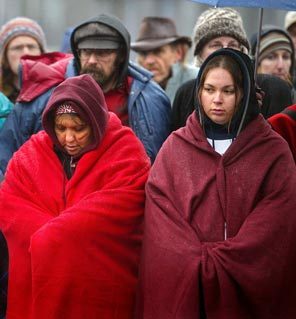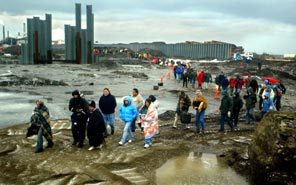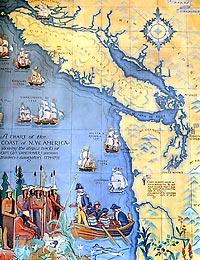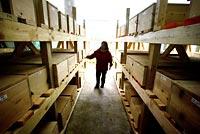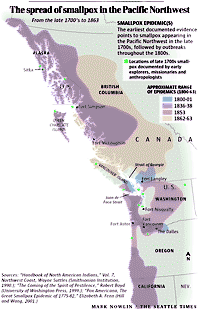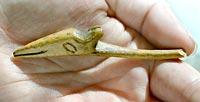Originally published May 23, 2005 at 12:00 AM | Page modified March 16, 2010 at 5:00 PM
"How could so many die?" Graves may tell story of terrible epidemic
Some graves at the Tse-whit-zen site may document a turning point in Northwest history: the arrival of European explorers — and the diseases that ravaged native populations.
Seattle Times staff reporter
STEVE RINGMAN / THE SEATTLE TIMES
Lower Elwha tribal members prayed and wept with supporters at a healing ceremony last January in Port Angeles to honor the spirits of 335 of their ancestors unearthed during a state construction project. Spiritual adviser Mary Anne Thomas of the Esquimalt Nation in British Columbia is at left, front, with Lower Elwha tribal members Arlene Wheeler, center, and Carmen Charles, right.
STEVE RINGMAN / THE SEATTLE TIMES
Lower Elwha Klallam tribal members lead neighboring tribes, construction workers, public officials and local residents in a solemn walk around the site to conclude the healing ceremony in January. Sheet piles, driven into the ground for the dry-dock project, shut down a month earlier, are visible to the rear.
This mural in the Smith Room of the Suzzallo Library at the University of Washington, painted by Paul Gustin and John Jacobsen, represents the history and exploration of the Pacific Northwest.
Some of the many graves exhumed at the site may have been filled with the victims of smallpox and other diseases brought by Europeans in the 1700s. Frances Charles, chairwoman of the Lower Elwha Klallam tribe, counts cedar boxes full of ancestral remains dug from the site. They still await reburial.
Some called it the Spirit of Pestilence, a terrifying death force borne on ships, trade goods and even the very breath of family members.
Beginning in the 1770s — maybe earlier — outbreaks of infectious diseases, including smallpox, influenza and measles, scythed through native tribes of the Northwest Coast, killing an estimated 80 percent of the population within 100 years of their first contact with whites.
Probably brought by Spanish explorers, the epidemics were a devastating force of history, the single largest cause of the drastic decline in population of coastal Indians.
Now archaeologists wonder if some of the many graves found at Tse-whit-zen, the ancient Klallam village recently unearthed at Port Angeles, bear direct witness to that suffering.
If so, it would be an unprecedented Northwest archaeological find.
"If that is what we see there, it would be so exceptional," said scholar Robert Boyd of Portland, author of "The Coming of the Spirit of Pestilence," a history of infectious diseases and population decline among Northwest Coast Indians from 1774 to 1874.
While tribal oral traditions and the written records of explorers, missionaries and traders are replete with stories of the epidemics, few gravesites survived.
A look at how smallpox spread from the late 1700s to 1863
So devastated were tribal villages by diseases that in many instances few survived to bury the dead, who were simply left where they fell. Their remains were looted, washed away or scattered.
But at Tse-whit-zen, Lower Elwha Klallam tribal members worked alongside archaeologists to remove the intact remains of 335 of their ancestors and thousands more bone fragments.
An uncounted number of the tribe's ancestors remain in the ground.
Evidence of an epidemic?
Spanish explorers traveling the Strait of Juan de Fuca are believed to be among the most likely sources of a smallpox epidemic that struck tribes throughout the coastal area beginning in the 1770s.
"And that initial epidemic is probably what we see here at Port Angeles," said David Rice, senior archaeologist with the Seattle district office of the U.S. Army Corps of Engineers.
Clues that might date some burials to the epidemic era include trade items found with the graves, such as a bayonet and trade beads from China and Russia.
Radiocarbon dates obtained from soil samples also indicate that some burials date between 1780 and 1800. Many of the graves hold multiple skeletons and show unusual ritual treatment, "which would be a spiritual attempt at trying to stop this event," Rice said.
Science, culture collide
When the 9,300-year-old bones of the so-called Kennewick Man were found in the water and along the bank of the Columbia River in 1996, a custody dispute erupted between scientists and Native Americans.
Were the remains a prime target for scientific research — or the sacred property of local tribes to be returned for reburial without further disturbance?
In February 2004, a federal appeals court ruled that scientists could study Kennewick Man. While tribes didn't challenge that decision, they are seeking through the courts to get input on — and perhaps limit — studies of the remains.
At Tse-whit-zen, differences between scientific research practices and the Lower Elwha Klallam tribe's cultural and religious beliefs surfaced repeatedly.
Archaeologists disagreed with the Lower Elwha over using a spray of water to sort material dug from the site, standard practice in the field. Tribal leaders, who first agreed with the plan, later argued that using water would rinse bits of their ancestors — bone dust and fragments — into the Strait of Juan de Fuca.
Lynn Larson, an archaeologist hired by the state to oversee the dig, stuck with water screening, the method several agencies had agreed to in a treatment plan directing the dig.
The tribe's spiritual adviser wanted the skeleton of a dog and the bones of a woman believed by archaeologists to be white buried with the ancestors. "They were part of the community," said Frances Charles, tribal chairwoman.
No dice, archaeologists said.
The tribe also preferred that intact skeletons and countless bone fragments, grave offerings, burial boxes and even the soil touching the bones not be analyzed.
Bones were minimally cleaned; the estimated age, sex, and height of the deceased was noted, but little additional study was allowed.
Analysis of the bones might have shown evidence of some of the diseases that struck the Klallams, and whether the deaths coincided with epidemics that decimated the tribes.
Archaeologist Glenn Hartmann, who worked with tribal members to exhume many burials, bent some of his usual requirements to accommodate the tribe's wishes. Initially, he refrained even from making detailed sketches of the graves. Instead, he made only general notes. He didn't photograph any burials until he had gained the tribe's trust.
"There were cultural constraints on the scientific investigation," he said. "We worked hard to accommodate the tribe's concerns and values."
— Lynda V. Mapes
![]()
Skeletons were found buried with their heads cut off, with their hands covering their faces, and face down. Archaeologists wonder if those might have been spiritual teachers or medicine men, punished for a frightening epidemic.
Skeletons and burial boxes were thickly dusted with red ochre for spiritual protection. Many etched stones with sacred teachings were found with the burials, and a cache of the stones was found discarded in a refuse pit.
Archaeologist Lynn Larson, one of the principal investigators for the site, wants to determine whether burned house planks and large numbers of intact, carefully made stone tools that appear to have been left behind could point to a village swiftly abandoned.
Then there are the graves of the children, dozens of them 12 years old or younger.
"I got all the kids, all the infants," said tribal member Lonnie Charles, who helped remove burials so the construction project could continue. "You wonder: How could so many die? There has to be a reason to have so many infants die in one village."
Alternate explanations
Archaeologists caution that they are still analyzing data from the site, and looks can be deceiving.
Layers of burials could represent epochs of time, one atop another, rather than a mass grave from a single episode of disease. Hasty burials could also denote the low status of the dead.
What are believed to be the bodies of slaves, captives and other low-status residents of the village may have been placed without ceremony on refuse piles.
More radiocarbon dating of soil and artifacts, as well as other data from the site, may help solve the mystery.
But the question may never be fully answered.
So far, the tribe won't allow analysis of the bones, the ground they touched or grave offerings buried with them. They believe that would be disrespectful of their ancestors.
Turning point in history
The epidemics were an important turning point in Northwest history and the history of the Klallam tribe.
Not war, but disease, accidentally transmitted through trade and other contact, decimated the Indian population of the Northwest, according to Boyd.
That set the stage for an influx of white settlers.
Working from ships' logs, explorers' diaries and other primary sources, Boyd found that in the late 1700s, when non-Indians began to visit the Northwest, they encountered cultures that were "vigorous, rich, diverse and strong."
But between the first contact with Europeans and the last major epidemic in 1875, the Northwest Coast people endured several consecutive plagues: smallpox, malaria, measles, influenza.
Early historical accounts collected by Boyd offer haunting portraits of empty villages, with a few pockmarked survivors.
Tribal oral traditions speak of smallpox sufferers marked with lesions — "many mouths" — and people who killed themselves rather than die like those around them.
"The hurt is still there," Boyd said. "The bereavement through the generations is still there. The whole contact experience has done this to them, and this is just the first blow."
The population of the Klallams was estimated to be around 3,200 before 1770. By the 1840s, census accounts tallied about 1,485 Klallam people — and there were only about 485 in 1880.
Soon after, the Klallam bands, once among the fiercest warriors on the coast, signed treaties ceding their lands.
Settlers poured into the territory. The Klallam people would never be a majority in their homeland again.
But the Lower Elwha, who call themselves The Strong People, didn't disappear.
Tribal members tried to chase off sea captain Alexander Sampson in 1856 when he staked his 320-acre land claim where the tribe had located its cemetery, according to the late historian Harriet Fish of Port Angeles.
Sampson persuaded the Indians to let him stay — as long as he didn't bother the graves.
Carefully carved spoon handles show the artistry of even everyday objects at Tse-whit-zen. They have a value to members of the Lower Elwha Klallam tribe beyond beauty or scientific interest.
And the cemetery was still a local landmark in 1865 when Caroline C. Leighton, the wife of the first customs officer of the territory, described it in her travelogue, "West Coast Journeys":
"In the large trees on the land were suspended canoes holding the mummies of Indian chiefs, and in the graveyard on the beach, the graves were gay with bright blankets, raised like flags, or spread out and nailed upon the roofs over the graves and myriads of tin pans, as many as 30 on one grave."
As the Washington Pulp and Paper Corp. excavated footings for the pilings of a nearby mill in 1920, the local paper reported "... hundreds of Indian bones were disturbed when the ground was being broken."
To Frances Charles, chairwoman of the Lower Elwha Klallam Tribe, scientific samples aren't needed to figure out what happened to some of the people found buried in and around the area that came to be known to archaeological workers as "No Man's Land."
At most burial sites, skeletons were found placed carefully in a flexed position, knees to chin, in cedar boxes or wrapped in cedar mats, along with medicines, tools and favorite belongings for the journey to the next world.
The burials of what Charles thinks were smallpox victims were different.
"There was no preparation," Charles said. "They were placed on top of each other. They were right next to each other, they were placed embracing as if husband and wife. We had witnessed a child still in the womb of the mother, we had witnessed a child and a mother embraced with each other.
"It was something they had to do to in a real hurry to protect themselves and their community."
Lynda V. Mapes: 206-464-2736 or lmapes@seattletimes.com
UPDATE - 09:46 AM
Exxon Mobil wins ruling in Alaska oil spill case
NEW - 7:51 AM
Longview man says he was tortured with hot knife
Longview man says he was tortured with hot knife
Longview mill spills bleach into Columbia River
NEW - 8:00 AM
More extensive TSA searches in Sea-Tac Airport rattle some travelers
![]()

Entertainment | Top Video | World | Offbeat Video | Sci-Tech
general classifieds
Garage & estate salesFurniture & home furnishings
Electronics
just listed
More listings
POST A FREE LISTING


